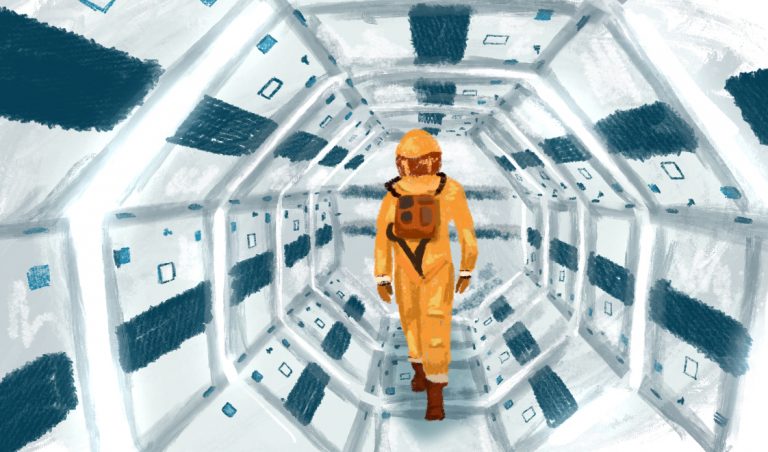More than 50 years after its initial release, 2001: A Space Odyssey continues to amaze, laugh, and leave audiences at their local cinema wanting more. During the film’s short breaks, audience members roared with excitement. Some were confused, others thrilled. I felt both, in awe of filmmaker Stanley Kubrick’s technical prowess and his ability to craft a future that’s close to home. In an age of rising artificial intelligence, it’s both chilling and exciting to see Kubrick’s vision of AI, which predated 21st-century models of language learning.
2001: A Space Odyssey is a timeless sci-fi epic filled with unanswered questions, mesmerizing visual effects, and the coveted Kubrick gaze, an iconic technique showcased throughout the director’s films. Kubrick loved to enter into conversations with his audiences, and this film is a perfect example of how people question their relationships with technology, each other, and life itself.
The main antagonist of 2001: A Space Odyssey, an artificially intelligent supercomputer named HAL, is the kind of character you just can’t hate. Nearly “perfect”, HAL has a clear goal of completing any mission he’s given, and he doesn’t let anything get in his way. HAL is a beautifully written red light, and all of his power comes from voice actor Douglas Rain and his understated yet powerful lines.
Although he’s one of the most fearsome AIs ever, attacking crew members and locking protagonist Dave (Keir Dullea) out of the spaceship, HAL also has some pretty funny moments. A fan-favourite scene sees HAL eventually die, but remain calm and collected as he was programmed to be and call for help.
Today, we live with our own supercomputers, but the only difference between our technology and HAL is that our reality, like all of us, is flawed and subject to tampering. HAL is calm and confident, and your iPhone may initially behave in the same way, but our trust in our creations has changed over the past 50 years.
The film is divided into four parts: “The Dawn of Mankind”, “Mission to the Moon”, “Mission to Jupiter” and “Jupiter and Beyond”, each of which feels like an independent yet intertwined story. The role of the mysterious monolith, an alien artifact with eerily perfect right angles, is crucial to each of the four parts of the film. In the first part, it is first discovered by primates millions of years ago, and the tribe screams at this unexplained structure, but comes to worship the discovery together. The entire film revolves around the monolith. In the second part, another monolith is discovered on the moon, and the objective of the third part is to find the structure further out in space.
The final scene of the film, Jupiter and Infinity Beyond, left me stunned to say the least. Dave watches himself age until he can only assume he will merge with it. Coming full circle, 2001: A Space Odyssey is the ultimate journey. Through his explorations of color, light and sound, Kubrick was literally living in the future while writing, directing and producing the film.
Seeing 2001: A Space Odyssey at Cambridge’s Brattle Theatre was a fun experience for me as it was my first visit to the Harvard Square-adjacent theater. The theater’s creative director gave a welcoming introduction to the film before the screening, and did a great job of explaining what audiences are going to see the film for, whether they are in the theater or with friends. In this age of increasingly popular streaming services, maybe the Brattle’s creative director had it right. Laughing with a community of passionate fans is a special experience.
The film left an open ending where unanswered questions come to fruition as everyone talks about the adventure that was 2001: A Space Odyssey. Captivating audiences of all ages, the film has been inviting us for decades to explore the unknown – the unpredictable. We know that it’s scary to see the future beyond the stars, because history repeats itself, but Kubrick has shown us that our possibilities are indeed limitless.


